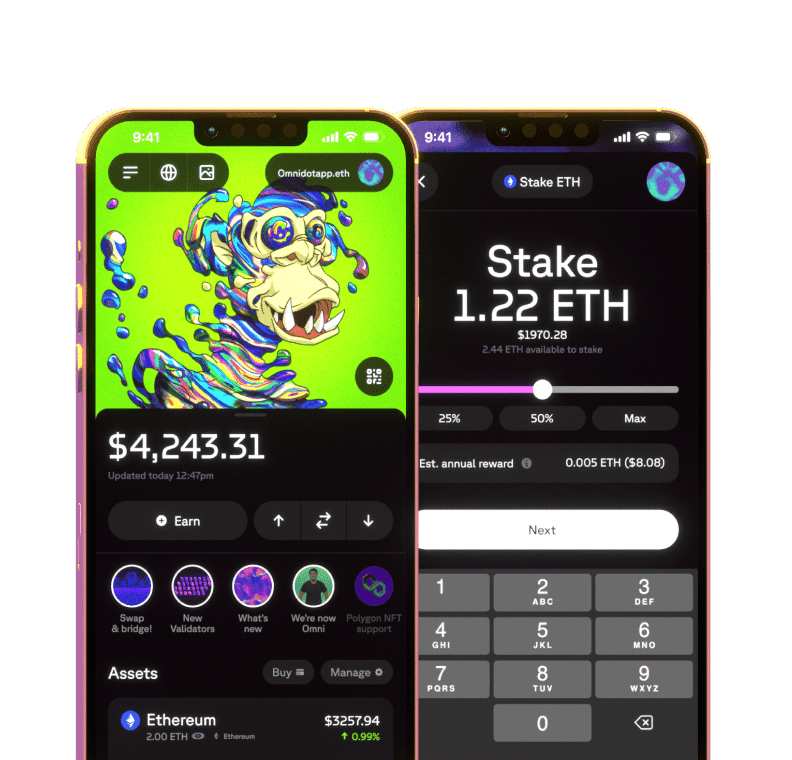Ethereum vs Solana - Which one should you invest into?
Ethereum and Solana were built for different purposes. In fact, Solana was built in response to Ethereum's slow transaction speed. Before its transition to Proof of Stake, Ethereum was only able to conduct ~20 transactions per second (TPS), allowing Solana to reign over the platform in terms of scalability, with its 60,000+ TPS. Over the past two years, Ethereum has responded to its low throughput by upgrading to Ethereum Proof of Stake (POS), which will let the chain scale up to thousands of transactions per second. Although both chains now are fighting head on to achieve speedy transactions, there are many other differences that mark the two popular networks. This article will allow you to understand the major difference between Solana and Ethereum and consider which one you should opt for based on the type of application you care about.
We will look into each platform's prospects in earning in terms of token price, and staking & lending returns, the state of their ecosystem including NFTs and DeFi, and the useability of the networks in terms of scalability and general user-friendliness. Let's go!
Ethereum
The world is most familiar with the most popular token, Bitcoin. Ethereum comes in second place and is one of the most favored blockchain platforms for creating decentralized applications. Ethereum pioneered the operations of smart contracts and continues to make transaction among peers much more secure than most of its competitors. The network experienced its largest viral season when digital collectibles proliferated its scene through the popular game, Cryptokittties, Since then, Ethereum has been dominating the market of digital collectibles and onboarded a mass of non-Web3 users through the NFT innovations in its ecosystem.
Solana
Solana is one of the top contenders of Ethereum. The most intriguing feature of the platform is its efficiency. Solana is known to process around 50,000 to 65,000 transactions every second, making it one of the fastest blockchain platforms available. The platform pioneered the Proof of History algorithm, which enables faster processing time and lower transaction costs. It is currently the quickest blockchain platform available to developers for creating scalable applications and due to this, it has the most efficient ecosystem.
Earning potential: Ethereum vs Solana
As of the date of this writing, Ethereum's native token, Ether (ETH), is priced at 50 times the amount of SOL.
Both Ethereum and Solana are Proof of Stake blockchains, allowing their token holders to stake their tokens for a healthy return. You can stake regularly and liquid stake both ETH and SOL. Here is a table of the returns for staking each token:
Ethereum | Solana | |
|---|---|---|
Regular Staking | 4.2% + additional rewards | 5.21% |
Liquid Staking | 5.45% (stETH) | 5.52% (stSOL) |
With regular Ethereum staking you'll need to stake at least the minimum amount - 32 ETH. Besides the staking rewards, you'll also receive MEV rewards (currently 1%) and transaction fees (around 3%), however, both numbers are subject to change.
On top of staking, users can also use lending platforms like Mango markets and Raydium to make returns that can go up to 10% with their SOL. Similarly, users can also plug into Curve and other protocols to generate returns that can go up to 10% with your stETH as well.
Earn more with stETH Earn more with stSOL
dApp landscape: Ethereum vs Solana
Ethereum continues to have the higher number of app developments in its ecosystem, with approximately 3,000 dApps built while Solana has around 400 dApps built on top of its network. Naturally, this is a given since Ethereum has existed for a much longer time than Solana. Since Ethereum is also known for its rock-solid security and dev support, many developers are very attracted to build on the platform. However, with the high network fees of Ethereum, Solana dApps attract users who are cautious about added gas costs on top of their base transactions.
For example, the network fee for minting an NFT on Solana could cost from $0.04 to $0.12 while that on Ethereum could range from $10 to over $150. Due to the popularity of the Ethereum network, the average cost to buy an NFT on Ethereum ranges from $1,400 to over $4,600, contrasting with the more affordable range of $100 to $1,000 on Solana.
With the overwhelming amount of support by devs for Ethereum however, the Ethereum network is the king of DeFi. The platform is supported by most major lending and borrowing platforms including Aave, Curve, Compound, and 1Inch.
Useability: Ethereum vs Solana
The greatest question around useability comes down to cost, efficiency, and ease of use. If a network is too expensive to use, then accessibility will be much lower. Currently, although Ethereum is the most popular network, it continues to incur the issue of expensive network fees. On top of that, it is unable to compete against Solana when it comes to transaction speed as of current TPS metrics, although this might change as Ethereum continues to work on its scalability with its transition to Proof of stake.
But, Solana comes with its own problems as well. The platform is notorious for experiencing constant network outages. Outages took place almost consistently each month earlier this year with the PoS network going down in April, May, June, and July. With decentralization being a core tenet of Web3, and a priority for many users, Solana is also a turn-off as the network is far more centralized than Ethereum.
Overall, both networks have their pros and cons when it comes to useability. While Ethreum lags behind on throughput and cost efficiency, it makes up for appeal in terms of decentralization and provision of a comprehensive range of applications for users to play with.
FAQ
Why is Solana called Ethereum killer?
Solana was created in response to Ethereum's issues of scalability. During Solana's genesis, Etheruem had a throughput of 20 transactions per second. With Solana's entrance to the scene with a promise of throughput of over 60,000 transaction per second, Solana created mass conversations around Ethereum's inability to provide users with a fast and efficient network.
Today, Ethereum is working on its scalability issues. The network is on a path to develop its scaling solutions through L2s and sharding technology, allowing it to compete with the likes of high-scale platforms like Solana.
Will Solana be bigger than Ethereum?
At the moment, this is only up for speculation. Whether Solana gets bigger than Ethereum depends on a myriad of factors including the number of developers that build on Solana compared to Ethereum, the efficiency of Ethereum compared to Solana as it progresses into its Proof of Stake technology, and the stability of the Solana network over time.

 Omni -
Omni -